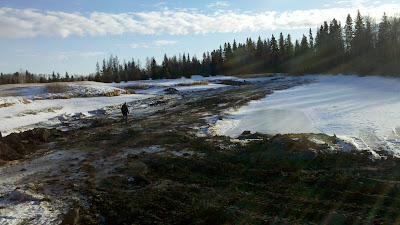 We have added a new ice removal technique to our list of experiments. We rented two glycol heating units that use diesel burners to heat glycol that is circulated through long rubber hoses. The concept is not unlike in-floor heating that depends on the even distribution of the heat from the hoses to provide heat over the expanse of the floor. We used insulated construction tarps between the evergreen tarps and the hoses to help the hoses provide more uniform heat over the surface. Two more layers of insulated tarps over the top of the hoses help contain the heat and reduce heat loss to the air. We checked a number of times during the day and melting was seen almost instantly where the hoses were in direct contact with snow or ice but under the insulated tarps, melting was a very slow process. We let the units run overnight and checked the results in the morning.
We have added a new ice removal technique to our list of experiments. We rented two glycol heating units that use diesel burners to heat glycol that is circulated through long rubber hoses. The concept is not unlike in-floor heating that depends on the even distribution of the heat from the hoses to provide heat over the expanse of the floor. We used insulated construction tarps between the evergreen tarps and the hoses to help the hoses provide more uniform heat over the surface. Two more layers of insulated tarps over the top of the hoses help contain the heat and reduce heat loss to the air. We checked a number of times during the day and melting was seen almost instantly where the hoses were in direct contact with snow or ice but under the insulated tarps, melting was a very slow process. We let the units run overnight and checked the results in the morning. The morning results were encouraging as far as amount of ice actually melted. In most spots, the hoses had melted approximately 5-8cm on either side and in some spots, depending on the thickness of the ice, the melt was even more. In most cases the ice was 5-8mm thick but ranged up to 10-20mm and was dense and clear.
The morning results were encouraging as far as amount of ice actually melted. In most spots, the hoses had melted approximately 5-8cm on either side and in some spots, depending on the thickness of the ice, the melt was even more. In most cases the ice was 5-8mm thick but ranged up to 10-20mm and was dense and clear. To speed the melting process we removed the insulated tarp from under the hoses and tripled the insulation on top of the hoses. We found that ice melt results similar to the ones we saw overnight could be achieved in approximately 3 hours.
To speed the melting process we removed the insulated tarp from under the hoses and tripled the insulation on top of the hoses. We found that ice melt results similar to the ones we saw overnight could be achieved in approximately 3 hours. Finally, we placed the hoses directly on the turf with three layers of insulation over them and saw the most ice melt. In this spot we had the thickest ice cover, approximately 50-60mm. This thick ice cover was in the middle of the picture where you can see the large chunks easily removed with the shovel.
Finally, we placed the hoses directly on the turf with three layers of insulation over them and saw the most ice melt. In this spot we had the thickest ice cover, approximately 50-60mm. This thick ice cover was in the middle of the picture where you can see the large chunks easily removed with the shovel.Until the spring, it is impossible to say if this technique is worth the time and money it requires. There are concerns associated with heating the ground to remove ice and the turf will show us results, either positive or negative, in the spring. This method is very useful to remove ice cover but the effect on the turf is yet unknown.



